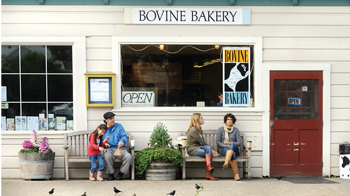Everywhere you look in Point Reyes Station you see history. The post office is located in the former railroad depot building—the terminus stop for the North Pacific Coast Railroad, which ran its last train in 1933—while the old engine house still stands a block from the vintage Greenbridge gas station and buildings like Cheda’s garage, the oldest AAA station in the West, and the large brick Grandi Building, constructed in 1915, carve iconic shapes into the downtown area.
“There is history all over the place,” says historian Dewey Livingston, who took over the mantle of local historian from its former holder, Jack Mason, after his death in 1985. “I’ve always been fascinated with history. I run across some old tree or foundation while hiking and wonder, what happened here?”
Livingston, who lived in Point Reyes Station with his wife and children for 15 years before moving to nearby Inverness, grew up in suburban Marin but felt the call of wide-open spaces. “As a suburban kid you can either go to the city or the country—I choose the country,” he says. “It is like living an old-fashioned life, with all the farms; we produce good food and it is a great place to raise kids.”
The author of numerous books on local history—Livingston just finished the new Nicasio: The Historic Valley at the Center of Marin and recently released the historic picture book Point Reyes Peninsula with co-author Carola DeRooy—is glad he narrowed his focus from county history to the West Marin area.
“You go on vacation and you come back and say, ‘Wow, we have it all here,’” he says.
According to third-generation rancher turned bed-and-breakfast owner Sharon Doughty, keeping “it all here” is sometimes the hard part. She says the numerous local ranches were forced to diversify in the ’90s and received support from the county in that survival effort. “If we can keep farming here there is no threat [to develop the land for other uses],” she adds. “We were one of the first to get through it all.”
Sharon and her husband, Steve, diversified by planting grapes suitable for champagne on seven acres of their 780-acre property and dairy farm. The first 40 gallons of bubbly they ever produced were served with great success at the wedding of Sharon’s daughter. “When we first poured it, Steve was pretty nervous,” Sharon admits.
Now Sharon’s daughter runs the dairy side of the business and Steve and Sharon have found happiness bottling and selling the 1,000 cases of champagne they make each year, running the Point Reyes Vineyard Inn, which is also on the property, and interacting with their family and community.
“My parents and my kids hang out all the time and that doesn’t happen much these days,” Sharon says about life on the farm. “There is a real sense of community here that I took for granted until I got older. Being a bed-and-breakfast owner made me realize what a great place we have.”
Local chef and restaurateur Christian Caiazzo discovered the same thing after moving to Point Reyes Station more than six years ago and opening Toby’s Coffee Bar and, just recently, the California/Italian restaurant Osteria Stellina in the location where Rosie’s Cowboy Cookhouse used to be.
“We wanted to move to a small town but not a typical town—we are very political about food and this seemed like the perfect place,” says the father of two, who has cooked for restaurants such as Globe and Postrio in San Francisco. “Two kids and two businesses later, here we are.”
Getting out of the urban restaurant experience and opening his own place in a town like Point Reyes Station offers numerous advantages over city life, Caiazzo says. “My kids are getting the chance to learn about food and where it comes from, where it is produced,” he says about his relationships with local ranchers, growers and fishermen, all of whom supply food to the restaurant. But n o relationships are as important as those formed with the people who live in town, he adds. “We have done really well so far. It is a huge relief; we have been really supported by the community.”
o relationships are as important as those formed with the people who live in town, he adds. “We have done really well so far. It is a huge relief; we have been really supported by the community.”
According to local real estate agent Robert Cardwell, the tight community of just over 800 (if you count those that live in the surrounding countryside) is as strong as ever. “Things are taking longer to sell and prices are flattening,” he says. “But the market is pretty strong.”
Cardwell says the 448 or so homes in the area hit a median price of around $1 million, with estate property topping out at more than $3 million. “This area is unique; there is nothing like it,” he says. “We are surrounded by national seashore and it is what it is. It is not going to change a lot.”


